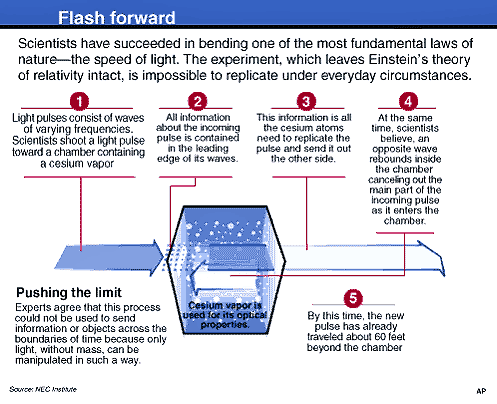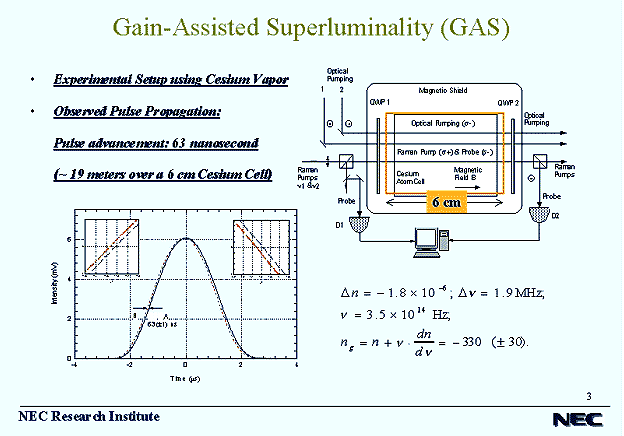|
|
|
from SkyBooksUSA Website
Light from the sun provides the energy needed for plant growth and plants convert the energy in sunlight into storable chemical form through a process called photosynthesis.
Petroleum, coal, and natural gas are the remains of plants that
lived millions of years ago, and the energy these fuels release when
they burn is the chemical energy converted from sunlight. When
animals digest the plants and animals they eat, they also release
energy stored by photosynthesis.
Photons are different from particles of matter in that they have no mass and always move at the constant speed of 300,000 km/sec (186,000 mi/sec). When light diffracts, or bends slightly as it passes around a corner, it shows wavelike behavior.
The waves associated with light are called
electromagnetic waves because they consist of changing electric and
magnetic fields.
Atoms are the
building blocks of matter, and the motion of one of their
constituents, the electron, leads to the emission of light in most
sources.
This 1997 Encarta Yearbook article describes their
success.
The team, which included researchers
from Stanford University, the University of Rochester in New York,
the University of Tennessee in Knoxville, and Princeton University
in New Jersey, published an account of their work in the September
1, 1997, issue of the journal Physical Review Letters.
In an atomic bomb blast, a very small amount of matter is converted
to its equivalent in energy, creating an immense explosion.
Collisions between the X-ray beam
and the atoms created matter in the form of sets of electron and
positron particles, a phenomenon known as pair production. Positrons
are particles that have the same weight and amount of charge as
electrons, but positrons are positively charged, while electrons are
negatively charged.
The photon then recoiled from the collision and rebounded into oncoming photons from the laser beam with such violence that the resulting energy was converted into an electron-positron pair.
Over several months of such experiments, the
physicists were able to produce more than 100 electron-positron
pairs.
The Greek philosophers from as early as Pythagoras, who lived during the 5th century BC, believed light issued forth from visible things, but most also thought vision, as distinct from light, proceeded outward from the eye.
Plato gave a version of this theory in his dialogue Timaeus, written
in the 3rd century BC, which greatly influenced later thought.
Early thinkers also observed and recorded the phenomenon of refraction, but they did not know its mathematical law. The mathematician and astronomer Ptolemy was the first person on record to collect experimental data on optics, but he too believed vision issued from the eye.
His work was further developed by the Egyptian scientist Ibn al Haythen, who worked in Iraq and Egypt and was known to Europeans as Alhazen. Through logic and experimentation, Alhazen finally discounted Plato’s theory that vision issued forth from the eye.
In Europe, Alhazen was the most well known among a group of Islamic scholars
who preserved and built upon the classical Greek tradition. His work
influenced all later investigations on light.
This was consistent with Planck’s theory, which suggested that a photon’s energy was related to its frequency. During the next two decades scientists recast all of physics to be consistent with Planck’s theory.
The result was a picture of the physical world that was different from anything ever before imagined. Its essential feature is that all matter appears in physical measurements to be made of quantum bits, which are something like particles. Unlike the particles of Newtonian physics, however, a quantum particle cannot be viewed as having a definite path of movement that can be predicted through laws of motion.
Quantum physics only permits the prediction of the probability of where particles may be found.
The probability is the squared amplitude of a wave field, sometimes called the wave function associated with the particle. For photons the underlying probability field is what we know as the electromagnetic field.
The current world view that scientists use, called the Standard Model, divides particles into two categories: fermions (building blocks of atoms, such as electrons, protons, and neutrons), which cannot exist in the same place at the same time, and bosons, such as photons, which can (see Elementary Particles).
Bosons are the quantum particles associated with the force fields that act on the fermions. Just as the electromagnetic field is a combination of electric and magnetic force fields, there is an even more general field called the electroweak field. This field combines electromagnetic forces and the weak nuclear force. The photon is one of four bosons associated with this field.
The other three bosons have large masses and decay,
or break apart, quickly to lighter components outside the nucleus of
the atom.
by Dr. Lijun Wang
The Speed of Light Is Exceeded in Lab
Scientists have apparently broken the universe’s speed limit.
For generations, physicists believed there is nothing faster than light moving through a vacuum - a speed of 186,000 miles per second. But in an experiment in Princeton, N.J., physicists sent a pulse of laser light through cesium vapor so quickly that it left the chamber before it had even finished entering.
The pulse traveled 310 times
the distance it would have covered if the chamber had contained a
vacuum.
Nothing with mass can exceed the light-speed
limit. But physicists now believe that a pulse of light--which is a
group of massless individual waves--can.
But by adding a bit of lead, it rises to 1.6.
The slower speed, and greater bending, of light waves accounts for the more sprightly sparkle of lead crystal glass.
The NEC researchers achieved the opposite effect, creating a gaseous medium that, when manipulated with lasers, exhibits a sudden and precipitous drop in refractive index, Wang said, speeding up the passage of a pulse of light.
The team used a 2.5-inch-long chamber
filled with a vapor of cesium, a metallic element with a goldish
color. They then trained several laser beams on the atoms, putting
them in a stable but highly unnatural state.
Yet at the end of the chamber, they recombine and reinforce one another to form exactly the same shape as the original pulse, Wang said.
The key finding is that the reconstituted pulse re-forms before the original intact pulse could have gotten there by simply traveling though empty space. That is, the peak of the pulse is, in effect, extended forward in time.
As a result, detectors attached to the
beginning and end of the vapor chamber show that the peak of the
exiting pulse leaves the chamber about 62 billionths of a second
before the peak of the initial pulse finishes going in.
It bends red more than blue in a process called "anomalous
dispersion," causing an unusual reshuffling of the relationships
among the various component light waves. That’s what causes the
accelerated re-formation of the pulse, and hence the speed-up
by Jonathan Leake
This would breach one of the basic principles in
physics - causality, which says that a cause must come before an
effect. It would also shatter Einstein’s theory of relativity since
it depends in part on the speed of light being unbreakable.
Dr Raymond Chiao, professor of physics at the University of California at Berkeley, who is familiar with Wang’s work, said he was impressed by the findings.
In Italy, another group of physicists has also succeeded in breaking the light speed barrier.
In a newly published paper, physicists at
the Italian National Research Council described how they propagated
microwaves at 25% above normal light speed. The group speculates
that it could be possible to transmit information faster than light.
He believes, however, that this will not breach the principle of causality because the time taken to interpret the signal would fritter away all the savings.
Wang’s experiment is the latest and possibly the most important
evidence that the physical world may not operate according to any of
the accepted conventions.
The process, known as
tunneling, has been used to make some of the most sensitive
electron microscopes.
Wang emphasizes that his experiments are relevant only to light and may not apply to other physical entities.
But scientists are beginning to accept that man may eventually exploit some of these characteristics for inter-stellar space travel.
|




